|
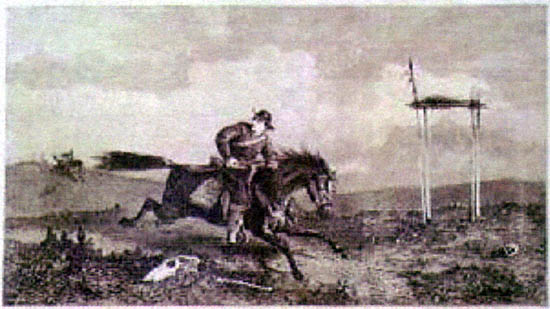
Pony Express rider.
With the threat of war in the East, the Oregon Trail took on a new importance as the route of communications between
California and the rest of the United States. Thus, the Pony Express was instituted. The details were laid out in an
announcement in the New York Tribune:
TO SAN FRANCISCO IN EIGHT DAYS
BY THE CENTRAL OVERLAND CALIFORNIA
AND
PIKE'S-PEAK
EXPRESS COMPANY
The first courier of the Pony Express will leave the Missouri River
on TUESDAY, April 3, at 5 o'clock, p. m., and will run regularly weekly
thereafter, carrying a Letter-Mail only.
The point of departure on the Missouri River will be in telegraphic
connection with the East, and will be announced in due time.
Telegraph messages from all parts of the United States and Canada,
in connection with the point of departure, will be received up to
5 o'clock p. m., of the day of leaving, and transmitted over the
Placerville and St. Joseph telegraph wire to San Francisco and
intermediate points, by the connecting Express, in eight days.
The Letter-Mail will be delivered in San Francisco in ten days from the
departure of the Express.
The Express passes through Forts Kearney, Laramie, and Bridger, Great
Salt-Lake City, Camp Floyd, Carson City, the Washoe silver mines,
Placerville, and Sacramento.
Letters for Oregon, Washington Territory, British Columbia, the
Pacific Mexican ports, Russian Possessions, Sandwich Islands, China,
Japan, and India, will be mailed in San Francisco.
Special Messengers, bearers of letters to connect with the Express of
the 3d of April, will receive communications for the Courier of that day
at No. 481 l0th st., Washington City, up to 2:45 p. m., on FRIDAY,
March 30, and in New York at the office of J. B. Simpson, room No. 8
Continental Bank Building, Nassau St., up to 6:50 a. m., of 31st March.
Full particulars can be obtained on application at the above places and
Agents of the Company.
WM. H. RUSSELL, President.Leavenworth City, Kansas, March, 1860.
Office in New York--
J. B. SIMPSON, Vice-President.
SAMUEL & ALLEN, Agents, St. Louis.
H. J. SPAULDING, Agent, ChIcago.
On April 3, 1860, J. W. "Billy" Richardson (Johnson William Richardson) on a bay mare departed from St. Joseph, Missouri, carrying mails destined to Sacramento.
And from Sacramento Harry Roff set out eastward. Fresh horse were required every 10-15 miles and fresh riders every 75-100 miles. A one-way trip would use
75 horses. Six days later, on April 9 at 6:45 p.m., the first rider from the east reached Salt Lake City. Utah. On n April 14, 1860, the first pouch was delivered to San Francisco.
Thus, mail was carried across the West connecting the nation in 10 to 12 days. A copy of
Lincoln's Inaugural Address was carried in only seven days and seventeen hours. But with the War, faster communcation was required.
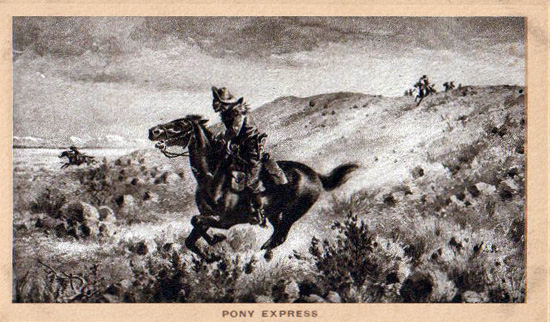
Pony Express rider, Robert "Pony Bob" Haslam, from a painting by H. H. Cross.
Haslam made one of the epic rides of the Pony Express, carrying news of Lincoln's election. He rode 120 miles in 8 hours, 10 minutes using
13 hours. On the ride he was shot through the jaw with an Indian arrow losing 3 teeth.
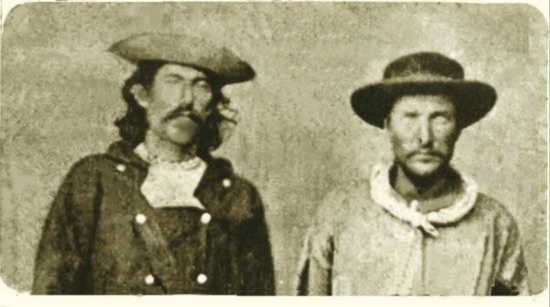
Pony Express Riders, 1860-1861.
Left, Billy Richardson; Right, Johnny Frye
Controversy exists as to who the first riders were. A contemporaneous account in the
St. Joseph Daily West gives credit to Richardson. With discontinuance of the line, Richardson disappeared.
In the 1930's, a W. B. Richardson appeared in Missouri, claiming to have been the Pony Express rider Billy Richardson.
He disclaimed the first ridership and gave credit to
Johnny Frye, also spelled "Fry" and "Frey." W. B. Richardson would, however, have only been about 10 years old at the
time of the Pony Express. As can be seen from the above photo, Richardson does not appear to be 10 or
11 years old. Newspaper
accounts from the time also indicate that J. W. Richardson was a fully grown adult having previously been a
sailor. The 1930's W. B. Richardson account also does not match newspaper or other description of the beginning
ride. W. B. Richardson describes the mail pouch as having been tossed to the rider. Other accounts indicate that
Wm. H. Russell, president of the line, personally adjusted the pouch on the horse, a far more likely scenario in light of the
special train and booming cannon that accompanied the send-off. Apparently, Frye was originally scheduled to be the first rider, but for an unknown reason Richardson was
substituted shortly before the mail was dispatched. Frye enlisted in Union forces and was killed by Confederate irregulars in 1863. Some of the confusion as to the first rider
from St. Joseh was that there was apparently a ceremonial ride of three blocks from the Pikes Peak Express stables at 9th & Penn to Patee House Hotel at 12th & Penn.
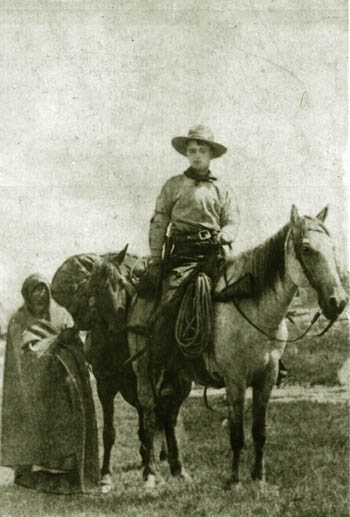 Frank E. Webner, Pony Express rider, circa 1860-1861. National Archives. Frank E. Webner, Pony Express rider, circa 1860-1861. National Archives.
Just as J. W. Richardson disappeared following the end of the Pony Express, other riders have vanished into
the pages of history. Such is Frank Webner. Census data indicates that there were several Frank E. Webner's. Most, however,
do not match on age. Two have been found, but they were born after the pony express ended and do not
have a life history which would match riding on the Frontier. One, as an example, was a CPA. One Frank Webner found
in the 1880 Kansas census was born in 1842. Webner, however, may be a transcriptional error in the census, since his
spouse was named Wegner and other Wegners were found in the same township.
And just as W. B. Richard's account of being a Pony Express rider is suspect, other suspicious claims
arose of participation as a rider. One, as an example, was "Charlie B. "Broncho Charlie" Miller who claimed to
have ridden for the line at age 11. However, some of the riders were in fact young. The average age of the riders was 19 and the youngest was
David Jay age 13 who rode the Seneca to Big Sandy run and occasionally rode as far as Julesberg. The rider were
well paid for the age, pulling down $100.00 to $150.00 a month.
William Lightfoot Visscher in his 1908
A Thrilling and Truthful History of the Pony Express cites a 1907 letter from Pony Express rider
J. H. Keetley crediting Alex Carlyle, a nephew of Company superintendent Ben Ficklin, as the first rider out of
St. Joseph. Keetley, however, gives the date of departure as April 16.
Carlyle dropped out of the service of the Company after about two months and died of consumption about six months later.
In addition to Roff, William "Sam" Hamilton has also been credited as the first rider leaving
Sacramento. Roff, however, was given credit by Alexander Majors.
The Pony Express did not use ponies. Instead, according to Pony Express farrior, Levi Hensel, the animals were half-breed
California mustangs. Hensel referred to the horses as "imps of Satan." He noted that it took
two men to hold a horse while the farrior trimmed the hooves and nailed the
shoes. Shoeing a horse took half a day.
The Pony Express was a financial failure, losing, according to Visscher $200,000 (in 1861 dollars, equal to between $6,000,000.00 and $8,000,000.00 today). Indeed,
while it was the wonder of the age, its rates, initially $5.00 for a half ounce letter, meant that the service was generally used
only by banks, news organizations, and for governmental dispatches. One of the more
important users of the service was the British for communication to India. The Suez Canal did not
open until 1869. Thus, messages were sent across the Pacific by ship to San Francisco, by Pony Express to St. Joseph, then by
telegraph to New York, and finally by ship to England.
The Pony Express was short lived. For almost immediately construction of the next great enterprise commenced, the great
Creighton Telegraph Line. As the telegraph line extended eastward from Sacramento and westward from Omaha, the Pony Express line became
shorter and shorter. On October 18, 1861, Creighton's line reached Salt Lake City. Six days later on October 24 the line from
California reached Salt Lake City. On the same day the western terminal for the Pony express in Placervile was closed. Two
days later the Pony Express was officially closed. The last mochilas were delivered in San Francisco in November.
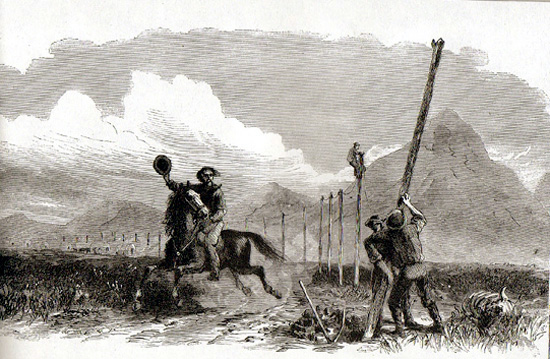
Pony Express rider passing construction crews for Creighton Telegraph line. Woodcut, Harpers Weekly, 1867. From a
painting by George M. Ottinger.
Next page: The Telegraph.
|